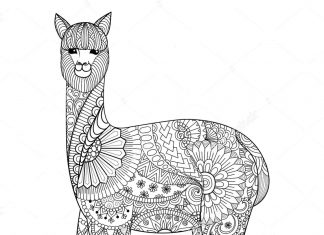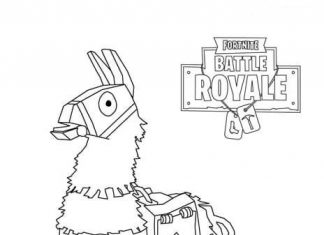The llama (Lama glama) is a type of hoofed mammal in the camel family, native to South America. It is a farm animal that has been domesticated by humans for many centuries and is used mainly as a draft animal, to carry loads, but also for its meat, skin and wool. Llamas are related to alpacas, guanacos and vicunas, which are also camelids that inhabit South America. Llamas are known for their calm and patient nature, although they may spit when they feel threatened or upset. They have long necks, large eyes, and are covered in thick fur that protects them from the cold in the mountainous regions where they usually live.
Coloring Book Lama
Information
- Origins: Llamas are domesticated and are native to the Andes Mountains in South America. The wild ancestors of llamas are the guanacos.
- Appearance: Llamas have long necks, large, expressive eyes and are covered with thick fur. They have banana-shaped ears and a slender body. Their fur can range in color from white to black, brown and gray.
- Application: Llamas are used by humans for a variety of purposes, including as draft animals, for carrying loads, and for meat, leather and wool. Their wool is soft and warm, as well as hypoallergenic, making it prized around the world.
- Nature: Llamas are generally calm and patient animals, but may spit when they feel threatened or upset. Spitting is a form of defense and communication between llamas.
- Reproduction: Pregnancy in llamas lasts about 11.5 months, and usually one cub is born. Young llamas are called cria.
- Diet: Llamas are herbivores and their diet consists mainly of grasses and other plants.
- Life expectancy: The average lifespan of a llama is about 15-20 years, although they can live longer if properly cared for.
- Cultural significance: Llamas are important to Andean cultures such as Ketchua and Aymara, and often appear in their art and mythology.
- Adaptations: Llamas are well adapted to life in the mountains, with the ability to withstand low temperatures and thin air at high altitudes.
- Classification: Llamas are part of the camel family (Camelidae) and are related to alpacas, guanacos and vicuñas. Alpacas are another domesticated species that is descended from vicuña, a wild camelid species from the Andes.
Curiosity
- Domestication: Llamas are one of the few animal species that have been domesticated in South America. Their wild ancestors are the guanacos.
- Spitting: Although llamas are usually peaceful animals, they may spit when they feel threatened, upset or want to express dominance. They spit stomach contents, which is unpleasant for the recipient, but not harmful.
- Service: Llamas were used by the ancient Incas as draft animals and to carry loads over mountains.
- Wool: Lama wool is highly valued for its softness, warmth and hypoallergenic properties. It is used to make a variety of items such as sweaters, hats and scarves.
- Cultural significance: Llamas have great cultural significance in the Andes and are often depicted in the region's art and mythology.
- Communications: In addition to spitting, llamas communicate through various sounds, including their characteristic "humming" and body positions.
- Diet: Llamas are herbivores and their diet consists mainly of grasses and other plants. They have a three-chambered stomach that helps them digest these plants.
- Adaptations: Llamas are well adapted to life in the mountains. They have red blood cells that are about 1.5 times larger than those of other mammals, allowing them to efficiently carry oxygen at high altitudes.
- Reproduction: A female llama usually gives birth to one cub (sometimes two) after a gestation of about 11.5 months. The cubs are able to stand and walk within the first few hours after birth.
- Height: Llamas can live at altitudes of up to 4,000 meters above sea level and higher, making them one of the few livestock adapted to living at such altitudes.



